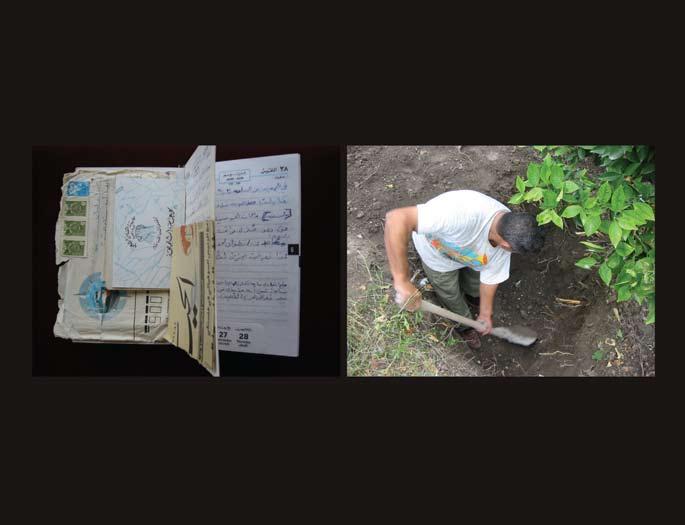
3 minute read
Akram Zaatari
from Tarjama/Translation: Contemporary art from the Middle East, Central Asia, and its diasporas
by ArteEast
LEBANON, 1966
Akram Zaatari’s In This House: Diagram with Olive Tree
Advertisement
Akram Zaatari frequently uses the alchemy of the editing suite to enhance certain qualities of documentary footage. Solarizing, linearizing, digitally isolating and superimposing forms have served to conceal (such as the gay men in How I Love You [2001], who don’t want to reveal their identity), to reveal implicit information (as in the silhouetted figures of water-bearers in This Day [2003]), and above all to reveal that the audiovisual image itself is not particularly replete with either experience or information. For Zaatari, the moving image obscures the world1: It is mute, it sees poorly, and it must be cajoled into expression. In This House, faced with a particularly dumb documentary image—“dumb as dirt,” as we say—resorts to strategies that recede from the audiovisual in order to tell the story of the little white house (and the five-story shell behind it).
The question that has guided Zaatari’s research for several years, namely the relationships between documents and history, of the Lebanese civil war and Arab history generally, leads ineluctably to abstraction. Imagine if it had been otherwise—if people could simply face the camera and tell the truth in whole sentences, if documents and artifacts immediately divulged their evidence, if every story corroborated the next. Then indeed, the movies could tell history. And In This House would be a heartwarming account of the meeting, after 15 years, between a Christian family and the secular Muslim fighter who lived in their house in the village of Ain el Mir for six years, safeguarding it when they were forced to depart. They would joke about the house’s quirks, tour the garden together, unearth the time capsule containing a letter the fighter had buried in the garden, and perhaps shed a tear for the terrible history, now safely terminated, of the Lebanese civil war.
But history is not like that, and hence movies cannot tell history. Most of the characters in this story (believing perhaps in the veracity of the moving image) refuse to appear on camera. Because of this, and because the act itself, of digging for the time capsule, is not very photogenic, the event barely registers visibly. The texts, tones and silhouettes that compensate for the absence of the people, render the video barely visible—a line drawing, an abstraction.
Despite the constraints that render In This House practically aniconic, the video makes many observations of events that occur along the continuum between material and symbolic. At one extreme of the image lies an abstraction so refined that it is utterly imperceptible: the state in all its arbitrary power. And at the other extreme, descending into the audiovisual image—into the long shots of the gardener Faisal patiently digging a large red-brown hole with his pickax, now and then showing his tired face to the camera—is the earth. The earth precedes images and swallows them up again. In This House observes the space in which images arise innocently from the earth, like mint in asphalt, and he observes how the earth gets coded over, becoming imperceptible again in the network of political meanings that gather up the surface of Lebanon.
Laura U. Marks
1 In fact, he seems to have more faith in the truth-function of still images, such as those in the archives of the Arab Image Foundation. See Vivian Sobchack, “The Scene of the
Screen,” for a discussion of how photography, cinema and digital media promote different relations of coevalness between viewer and image. In Carnal Thoughts: Embodiment and
Moving Image Culture (Berkeley: University of California, 2004), 135-163.
36










